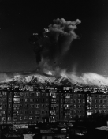
Avachinsky Decade Volcano, Kamchatka
volcano number: 1000-10= (according to Volcanoes of the World, 1994 edition)
summit elevation: 2741 m
location: 53.255°N, 158.830°E
Last changed on 19 March 1996
Avachinsky volcano during the first day of its unexpected 1991 eruption, following a 46-years repose period. View is over the outskirts of Petropavlovsk Kamchatsky, hardly a dream of a place ot live. The eruption that came without any precursors from this potentially highly explosive volcano was not the violent event expected to occur after the longest repose intervall of the current (i.e. post mid-18th century) active cycle. Its most notable feature was the complete filling of the formerly empty summit crater with black lava and formation of several small lava tongues on the upper slopes. Courtesy of B. Ivanov, 13 January 1991.
On 21 July 1996, the neighboring volcanoes of Avachinsky and Koryaksky were declared the sixteenth Decade Volcano, along with celebrities such as Vesuvio, Mauna Loa, Mount Rainier and Unzen. This decision will hopefully focus some more attention on Kamchatkan volcanoes and aid volcanological research and volcano monitoring.
Due to its proximity to Petropavlovsk-Kamchatsky (the largest pupulation center of the remote Russian peninsula), Avachinsky is one of the more notable of the active volcanoes of Kamchatka. During history (i.e. since its first recorded eruption in 1737), 16 confirmed and four questionable eruptions have occurred, some of them being quite violent. Eruptions occurred roughly once per decade until 1945 when Avachinsky ejected about 0.25 km^3 of tephra, in its largest historical eruption. During this as well as some of the more vigorous previous eruptions, the volcano produced glowing avalanches, on some other occasions, it emitted short lava flows.
Russian volcanologists until recently used to consider Avachinsky some kind of a "twin" volcano to Vesuvio, based mostly on the fact that both have young stratocones built within crescent-shaped calderas. However, there are a number of differences, the most important being that Vesuvio was in near-continuous eruption for more than 300 years until 1944 while Avachinsky did never manifest such a kind of persistent, low-level Strombolian activity interrupted by major Vulcanian eruptions. Neither has it ever erupted mafic magmas as did Vesuvio during the 1631-1944 eruptive cycle.
Beginning of the 1945 eruption of Avachinsky as seen from Petropawlovsk Kamchatsky on 25 February 1945.
Like Vesuvio, however, Avachinsky seems to have eruptive cycles, the most recent one beginning with the violent 1737 eruption, after about 200 years of repose. Assumptions that that cycle had ended with the 1945 eruption were disproved by the sudden 1991 eruption that occurred without any premonitory seismicity (it should be a frightening thought that Vesuvio might erupt again without any warning!). Neglecting another assumption, that any forthcoming eruption would be exceptionally strong after the long (less than 45 years) repose period, that eruption was of modest dimensions, causing only light ash falls in Petropavlovsk. The maximum height of the eruption column above the crater was 5-7 km. No pyroclastic flows were formed but after the fifth day of the eruption, lava rose up within the crater (between 400 and 500 m wide and 200 m deep) to completely fill it and overflow onto its S flank. The lava flow eventually became 1.6 km long. Smaller lava tongues overflowed the crater rim in other directions. The total volume of lava emitted was 12.7 x 10^6 m^3. The volume of ejected pyroclastics was very minor (about 0.3 x 10^6 m^3).
Culminating phase of the 1991 eruption: emission of numerous lava flows and emplacement of lahars on 17 January 1991, seen from the air. Photo by Ya.D. Muravieva, published in "Volcanology and Seismology" for 1994 (No. 3).
The activity lasted about 18 days. Since then, Avachinsky has had several episodes of increased seismicity but no new eruptive activity has occurred. A new episode of significantly increased seismicity and fumarolic activity was reported by the AVO on 8 March 1996, a possible precursor of a new explosive eruption. As of mid-July 1996, no eruption has occurred and seismicity has returned to background levels.